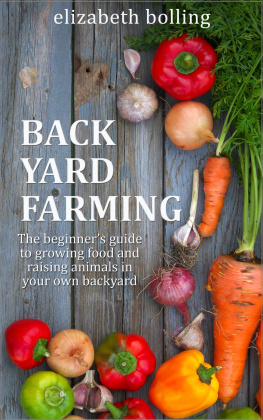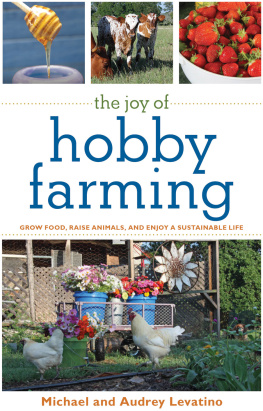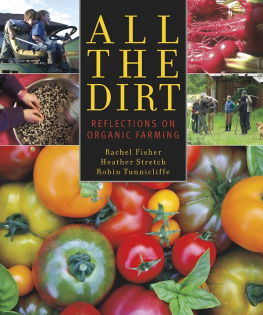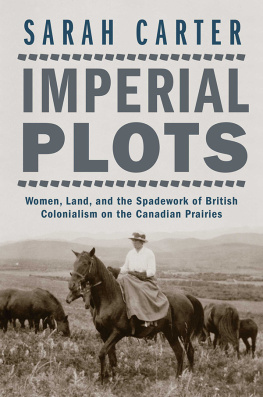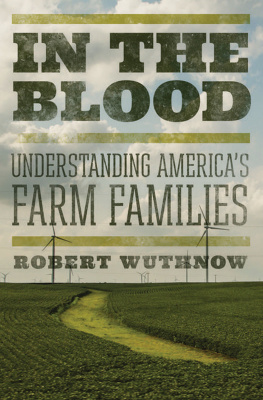Copyright 2015 by Audrey Blecha
All rights reserved. No part of this book may be reproduced in any form or by any electronic or mechanical means including information storage and retrieval systems without permission in writing from the publisher, except by a reviewer, who may quote brief passages.
ISBN: 978-1-581-57654-2 (e-book)
THE COUNTRYMAN PRESS
Woodstock, Vermont
www.countrymanpress.com
A division of W. W. Norton & Company, Inc.,
500 Fifth Avenue, New York, NY 10110
www.wwnorton.com
For information about special discounts or bulk purchases, please contact W.W. Norton Special Sales at or 800-233-4830.
Library of Congress Cataloging-in-Publication Data are available.
Woman-Powered Farm
PHOTOGRAPHS
All photography by Michael Levatino unless otherwise noted.
Page 9: Alessandro Surai/thenounproject.com; 18 HultonArchive/istock.com; 70: AmyNicole/thenounproject.com; 75: AleksandarNakic/istock.com; 85 IvonneW/istock.com; 86: Waleed Al-Alami/thenounproject.com; 100: ImagineGold/istock.com; 101: psceric/istock.com; 106: PJSouders/thenounproject.com; 132: meltonmedia/istock.com; 152: Marco Galtarossa/thenounproject.com; 157 mtreasure/istock.com; 164: NoDerog/istock.com; 178-179: Chart courtesy of Johnnys Selected Seeds, Johnnyseeds.com, 1-877-564-6697; 201: MentalArt/istock.com; 211: manfredxy/istock.com; 215: cjp/istock.com; 220: AdamZubin/thenounproject.com; 269: Kolbz/istock.com; 270: edelmar/istock.com; 272: pmayne/istock.com; 276: Gabrielle G./thenounproject.com; 318: Diego Naive/thenounproject.com; 322: Tracy Caruso;329: Anna Caruso
BOOK DESIGN AND LAYOUT
Nick Caruso Design

DEDICATION
To Michael

CONTENTS



Look around your local farmers market and the first thing youll notice is how many women are running the booths. Many are also the farmers who tended the goods theyre selling, whether its vegetables, flowers, eggs, or goat cheese. Visit any of your local farms that focus on organic growing methods and sustainability and it is likely that a solid majority of workers and interns on those farms are young women. But not just the smaller and sustainable farms are being run by women. Women are inheriting large farms in record numbers, and running large cattle and commodity operations. Women are noticeably visible as farm veterinarians, agricultural extension agents, and even as managers on the floors of meat processing plants. The face of farming, at least at the local level, has become decidedly female.

Why, after all the years of women (and men) moving off farms and into cities, is there a sudden return to the rural and agricultural work? Women worked for years to get off the farm and away from the constant labor of farm living. Before electricity and in the not-too-distant past, women were expected to help grow the food, make and wash the clothes, cook, clean, and do all the chores of child-rearing, all without the right to vote or the right to inherit the land.
War, a distinctly male pursuit, gave women more opportunities, first in the garden, but then, more important, off the farm. Women in the United States and Europe used their skills during WWI and WWII to raise food for the home front by developing Victory Gardens. Soon, however, there was need for more workers in other areas, so women learned skilled trades, formerly open only to men, and began working in factories, building planes and bombs while the men were away at war. Women continued advancing the industrial revolution that brought liberation in the form of dishwashers, washing machines, prepackaged foods, and other time-saving innovations. Technological advances also provide automated ways of completing farm chores. Farms that used such machinery required fewer actual farmers. Suddenly, women had more time in their days and could consider leaving the toil of the farm to pursue education and regular jobs. Women had left the farm for personal freedom and have made great strides since then in the business and academic worlds.
Far more women are in the workforce than ever before, but also growing numbers of women are leaving business to pursue agriculture. In the recent farm census, the percentage of woman-operated farms held steady at about 13 percent. The overall number of farms continues to drop, which has been an ongoing problem. But these numbers overlook a major trend of women incorporating into their lives farming and the growing of their own food. And many of the farm businesses that women are engaged inflowers, herbal products, artisan cheeses, plant starts, and farm craftsmay not be reflected in a farm census. Theres also a large group of community gardeners, urban farmers, and nonprofit farms that do not report to the census as farms, although they are certainly farming food to feed people. A recent article in the New York Times tracked down these farmers in the city and reported that these organizations, both the management and labor, are dominated by women. Many women in these agricultural and entrepreneurial pursuits think of themselves as growers or artisans in the local food community. Many are raising children as their primary pursuit, meanwhile growing produce on the side to feed their family and create a second income. They dont call themselves farmers, but they are certainly reshaping what farming is and how it affects local communities.
This book does not attempt to restrict the term woman farmer to only those women running and earning 100 percent of their living on a traditional farm. Women farmers are now as diverse a group as the country as a whole. They are becoming more diverse in a racial sensethe share of black, Asian, and Native American women farmers (who responded to the census), grew by more than 13 percent from 2007 to 2012but also in their pursuits. From the high school and college students spending their summer breaks interning on local farms, to mothers growing food for their families and selling the excess at the farmers market, to single women herbalists growing their own ingredients, to volunteers growing food for the poor, to older women whove inherited land from their husband and are now keeping cattle to protect their agricultural heritage, to artisan cheese makers that keep their own goats and sheep for the milk, the range of pursuits, ages, and experiences is as varied as women themselves.
The term artisan has been applied to many of the new, organic, and small producers of food that serve local communities and restaurants. And farming could be thought of as an art. Sure, there are artists who are making their living as painters and musicians. But most artists pursue their craft as a hobby or as a side income and most certainly as a lifestyle. You dont have to make a living at painting, sculpting, or playing music to be considered an artist. In the same sense, making a living should not be a requirement for being considered a farmer. And its women who are leading the way as artisans of agriculture.


